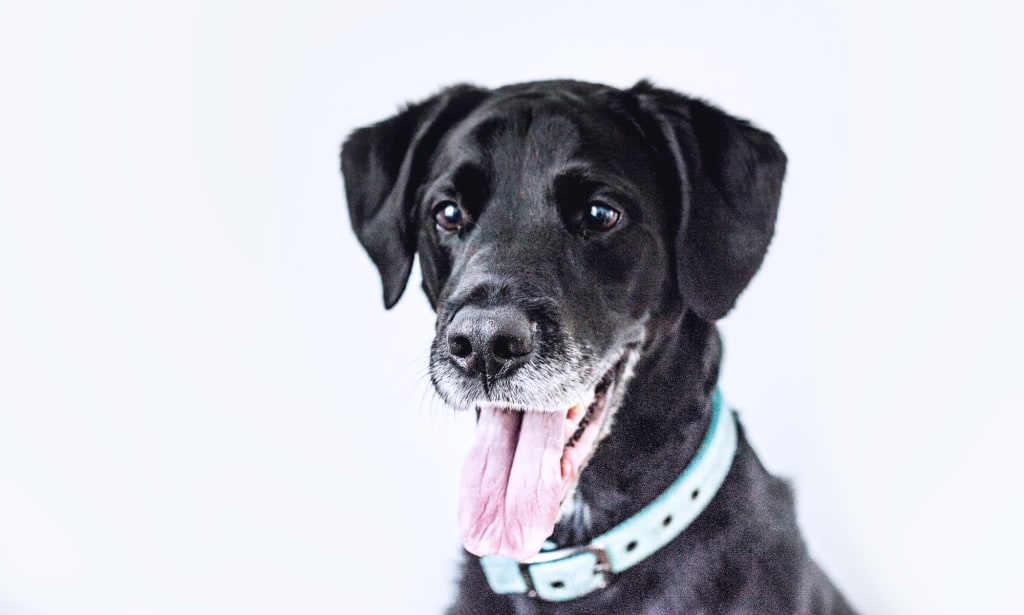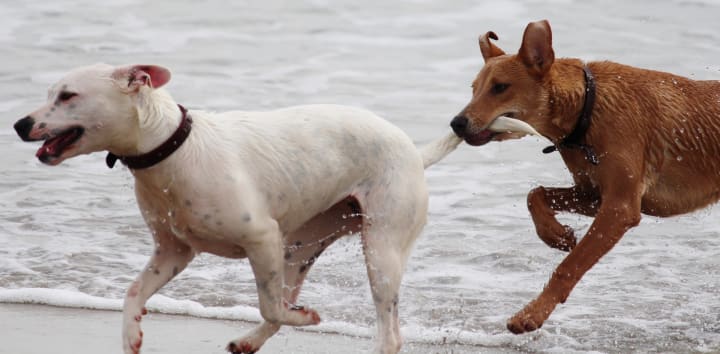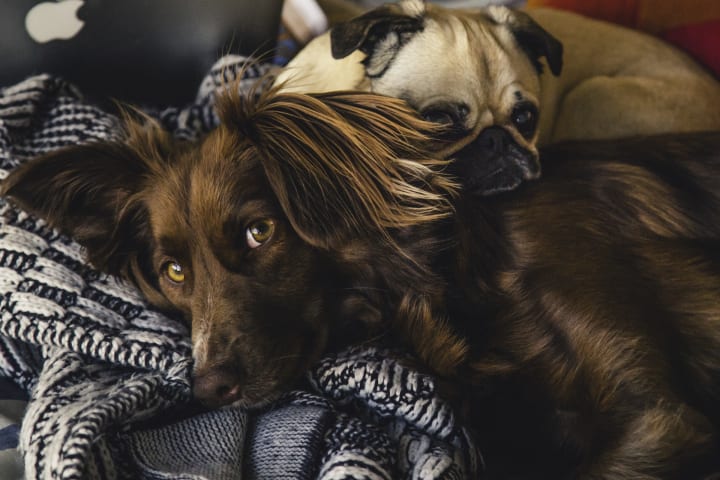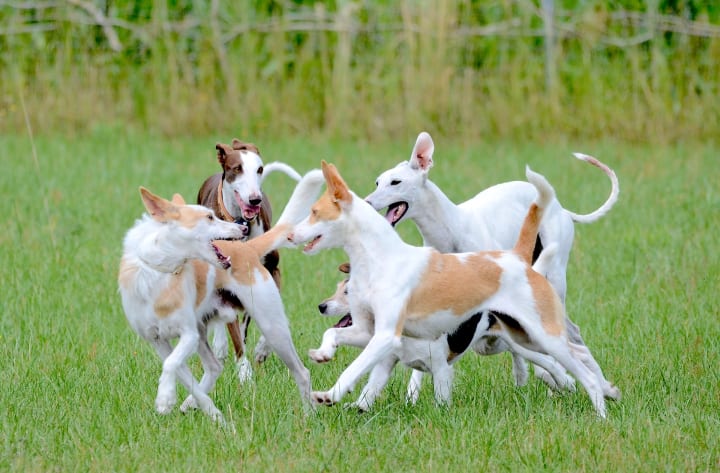Do Dogs Have a Sexual Preference?
Homosexual behavior is common in nature, but what about our pets? Do dogs have a sexual preference?

It’s a common scenario—you’re playing at the park with your dog and suddenly he's across the field, humping another male dog. While you try frantically to stop it, you're thinking "do I have a gay dog?" Homosexuality occurs naturally in humans, so do dogs have a sexual preference? The answer may be more complicated than you think. There are several examples of same-sex relationships throughout the animal kingdom (including some sex lives of animals that are surprisingly violent) that may be applicable to our canine companions. However, very little is understood about animal sexuality and what drives their sexual behavior. Here’s what we do know.
Dogs do what they want.

In many ways, animals may be more straightforward about sexual activity than their human counterparts. Dogs have no inhibitions and they don’t experience internal conflict about their sexual behavior. While some humans still feel a social stigma about certain sexual relationships, dogs are more likely to practice free love and they don’t care who’s watching. Because this behavior is out in the open, we are free to observe their sexual activity. But while their sexual behavior is on full display, it’s extremely difficult for humans to speculate on the motivation behind this behavior.
Jumping to Conclusions About Canine Behavior

Humans tend to anthropomorphize, meaning we assume that animals think and act the same way we do and for the same reasons. This leads to faulty conclusions when we study animal behavior and is a major reason why studying animal sexuality is extremely complicated. When evaluating human sexual behavior, we can conduct surveys or interviews to understand why people do what they do. When we study animals, we are limited to simple observation of their actions. While we can easily gather information about sexual behavior patterns, we can’t presume the motivations behind these behaviors or what satisfaction an animal gets from a sexual encounter. We observe instances of dogs that engage in homosexual sex but have very little idea about why it happened. This could make it somewhat problematic to assign any sexual orientation to a dog.
Homosexual behaviors are not homosexual preferences.

There’s no question that many dogs engage in homosexual behavior. Both male and female dogs hump members of the same sex. Male dogs mounting each other is very similar in appearance to homosexual sex. But this behavior does not necessarily mean dogs have a sexual preference. In humans, someone’s sexual identity is not just defined by the act of sex, but by deeper feelings of love and attraction. We don’t know yet if dogs experience these feelings at all. When we see a dog getting a little frisky with a member of the same sex, we assume he must have a sexual preference and are quick to label him as “gay,” but this is misguided.
Humping is not always sexual.

Most dog owners have experienced that awkward moment when your dog starts humping another dog, a house guest, or an inanimate object. We all have a laugh, but do we really understand the reason behind that behavior? There are several possible explanations for why a dog humps, and not all of them are sexual. Dogs that have been spayed or neutered still exhibit humping behavior despite having low levels of sex hormones, implying there is not a sexual motivation. Male dogs can hump other male dogs to exert dominance on them, not because they are sexually attracted.
An analogy is the sexual behavior that sometimes occurs in male prison populations, even though most of those involved would identify as heterosexual. Dogs will also hump because they are stressed, anxious, or excited. In puppies, it can even be consider play behavior. Lastly, humping has been observed between male dogs when they are exposed to a female dog in heat but are not provided access. It seems more likely that this is a result of sexual frustration rather than a sexual preference for other male dogs.
Homosexuality in the Animal Kingdom

There are several examples of homosexual behavior in nature. There are surprising dolphin sex facts, as well as information about giraffes, elephants, bats, bison, and orangutans which are just some of the mammalian species that have been observed mounting or demonstrating affectionate behavior towards members of the same sex. Several species of birds commonly engage in homosexual behavior, including black swans, ibises, vultures, pigeons, and penguins. For years scientists have observed females of the Laysan albatross species. They live in same sex partnerships for several years raising chicks cooperatively. During this time, they fend off any male albatross who approach the nest. Male penguins in zoos are known to form similar bonds with each other and will incubate eggs and foster penguin chicks together. It is still unknown whether an actual homosexual preference motivates this behavior.
Bonobos and Homosexual Sex

One primate species has the highest frequency of homosexual behavior in nature. While all great apes have been known to engage in homosexual activity (they are the closest to humans, after all!), the bonobos are considered truly bisexual. All bonobos have sexual encounters with members of the same sex and opposite sex within the group. It is thought that 60 percent of all sexual behavior in bonobos is between two or more females. However, it is postulated that sex is used to avoid conflicts within the group. To avoid fights over resources, bonobos often turn to sex rather than more violent physical confrontations. Sex limits aggression and fighting, allowing the group to thrive. While bonobo sexual behavior is certainly interesting, it doesn’t necessarily indicate a true preference for only the same sex.
Rams and Japanese Macaques

Now we know that several members of animal kingdom exhibit homosexual behavior. However, these species may be better described as bisexual—when given the chance they still mate with members of the opposite sex. It turns out there are species in which individuals have a definitive preference for a homosexual partner. The most well-known examples are male sheep and female Japanese macaques. It is estimated that up to 10 percent of rams have a homosexual preference and will only mount other males, even with access to healthy females. It was found that these rams had changes in parts of their brain and different hormone levels compared to their heterosexual counterparts. Japanese macaques are a great example on the female side. A certain percentage of female macaques have long-term homosexual partnerships which seem motivated by true sexual preference rather than social dynamics within the group. Like the male rams, the Japanese macaques preferred homosexual mating even when exposed a healthy member of the opposite sex. These examples indicate that a homosexual preference can exist in nature and some of the top LGBTQ+ animals, but do dogs have a sexual preference? So far, similar behavior has not been observed in our canine companions.
Sexual Behaviors of Canines in Nature

To answer whether dogs have a sexual preference, it would be wise to look at their closest counterparts in nature—other members of the genus Canidae. Wolves are the closest relative to the dog. Some wolves engage in homosexual activity. Much of this behavior is akin to what we’ve observed in dogs. Male and female wolves have been observed mounting members of the same sex. Males will hump another male wolf, but this may be more related to social status and establishing dominance within the pack rather than sexual preference. In most cases, male wolves seek the attention of females within the pack. We have not observed a preference for the same sex over the opposite sex or long-term homosexual relationships in wolves.
Do dogs even experience romantic love?

Homosexuality in humans is more about the act of sex. Humans in any type of relationship usually share deeper bonds—we choose partners based on personality traits and common interests in addition to a sexual attraction. There is an element of romance in most human relationships. People in same sex relationships haven’t chosen each other simply because they are the same sex, but for various other reasons. The same cannot be said for dogs. Healthy dogs will typically mate with any available member of the opposite sex. A dog’s mounting behavior towards same-sex dogs seems indiscriminate as well. They don’t appear to choose life partners or have any motivation beyond the act itself. If dogs don’t favor any specific members of the group, its tough to say they have distinct sexual orientations at all.
So, could my dog be gay?

Do dogs have a sexual preference? Probably not. There have been no studies in dogs that demonstrate an actual inclination for members of the same sex. Male dogs that mount other male dogs will have sex with a female when given the opportunity. The same is true for female dogs. While there are some examples in nature of animals that prefer relationships with members of the same sex, we have not observed this in the canine species. Animals that maintain same-sex relationships may do it for reasons other than sexual love or attraction, and humans shouldn't assume that we know those reasons. Until we can enter the mind and heart of animals to learn more about their sexual motivations, we should avoid assigning dogs with any particular sexual identity.
About the Creator
Lizzie Boudoir
Thrice married, in love once, overly romantic, and hypersexual.






Comments
There are no comments for this story
Be the first to respond and start the conversation.